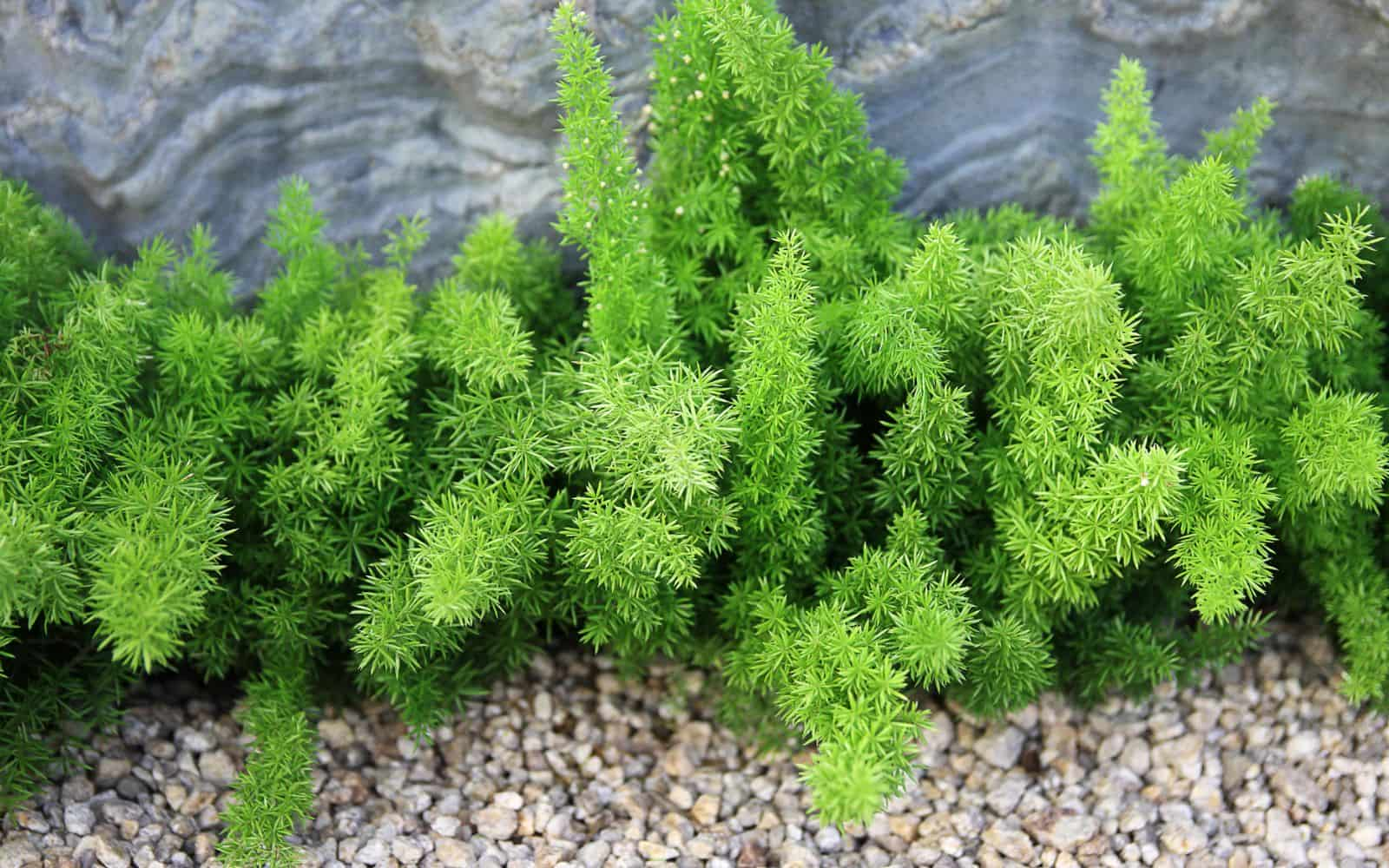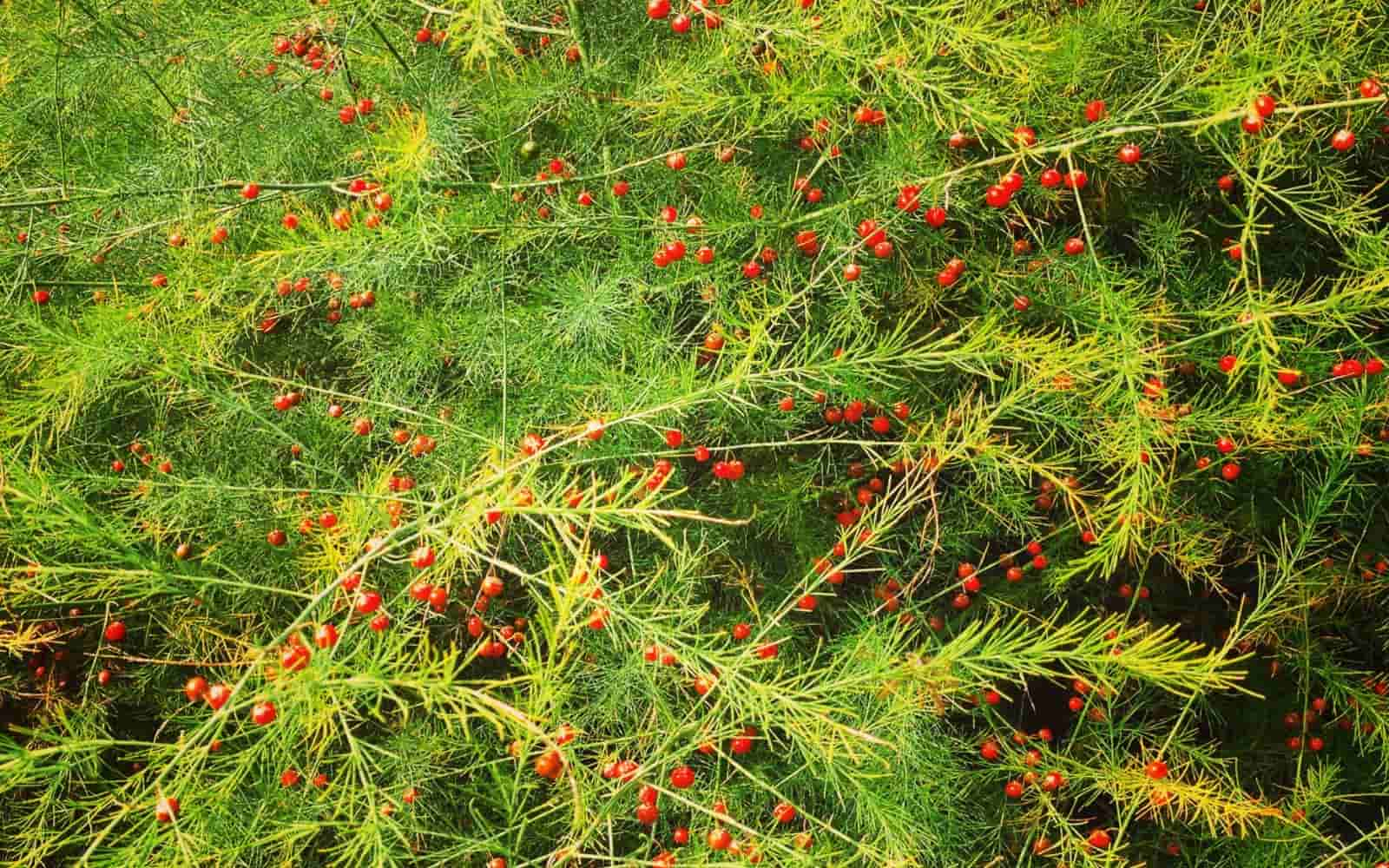Amazon has put together some great Home Gift Deals – save money and get your shopping done at the comfort of your home! Click here to see deals on Amazon
Asparagus plumosa ferns is an easy-to-grow houseplant that has threadlike decorative leaves. These tiny leaves spread vigorously, giving a feathery dark green true fern appearance.
It’s a great indoor plant that looks good on a tabletop or grown in a hanging planter to place over the porch. If you need some decorative bush around mature trees for an aesthetic vibe, it’s a great ornamental fern.
Let’s take a look and learn how to grow and care for Asparagus plumosa fern.
What is asparagus plumosa fern?
Plumosa fern is an ornamental perennial plant grown indoor and outdoor for its lush greenery. It’s from the Asparagaceae family and not a fern, but it gets its name due to its fern-like foliage. It grows in USDA plant zone 9 or above.
The Plumosa fern (Asparagus Plumosus) origin is from South Africa. It’s known by different names, such as asparagus grass, ferny asparagus, lace fern, and climbing asparagus.
The leaves of plumosa are tiny flat stem branches known as cladophylls that look like ferns. You should be careful handling these leaves as when it matures, it becomes hard and gets sharp.
You should wear gloves when pruning the plant to prevent any injury from thorns. When planted outdoor, it blooms small white flowers that mature into little red berries with seeds.
| Note | Specs |
|---|---|
| Scientific Name | Asparagus setaceus |
| Plant Type | Perennial, Ground Cover |
| Propagation | Root division, seed |
| Soil | Fertile, well-drained soil |
| Water | Max 2 – 3 times a week |
| Sunlight | Partial light |
| USDA Zone | 9 – 11 |
What are the types of asparagus fern?
In the wild, there are more than 300 species of the Asparagaceae family. The seven species are highly invasive and restricted. Here is some common asparagus fern:
Asparagus setaceus: It’s a climber plant that can grow up to 10 feet tall. It’s used in floral arrangements due to its unique ferns.
Asparagus aethiopicus: It’s also known as Basket asparagus fern that survives well on dunes and shallow headlands. It has long arching stems that grow up to 2 m long.
Asparagus africanus: It’s a climbing fern that can get up to 12 m high vegetation. It has narrow leaves and prickly stems that take over other vegetation.
Asparagus foxtail fern: It has a bushy appearance that looks like a foxtail. The light green stem grows in canonical shape up to 1 m long and 1.5 m wide.
Sprengeri Asparagus ferns: It has long stem with a fluffy spread that makes it easy to grow in a hanging planter.

How big does a plumosa fern get?
A fully matured plumosa fern grows 12 to 18-inch-long and spread 10 to 16 inches. It’s a fast spreader and invasive in warm climates. If planted outdoor and not controlled, it can quickly take over other vegetation.
The average plumosa fern planted in a container can grow up to 6 feet long and 2 feet high. It has an extensive root system that can spread up to 7.5 cm.
The roots are arranged in a rosette around a rhizome that grows vertically in the soil. You should prune it regularly so as not to let it grow unchecked.
How do you care for a plumosa fern?
You can grow plumosa fern to supplement your garden’s green appearance. We recommend that you plant it in a container as it makes it easier to control.
Plumosa ferns are highly invasive when planted outdoor. Here are some commonly asked questions about caring plumosa fern.
What kind of soil do asparagus ferns like?
Asparagus plumosa ferns require moist soil, and you shouldn’t let them dry between watering. You can prepare the ground with organic matter, potting mix with added perlite, and fertilizers. It gives plumosa the best-growing environment.
Asparagus is easy to grow and is sturdy enough to survive most soil types. But, they don’t like soggy soil, and you shouldn’t oversaturate the soil with water.
The addition of perlite helps remove excess water from the ground. You can mix peat moss to help the soil keep moisture naturally.
You should place the potting mix in a pot with drainage holes at the bottom. It helps get rid of excess water from the ground and prevents root rot. Maintain the soil pH between 6.5 and 6.8.
Do asparagus ferns need a lot of water?
Asparagus plumosa ferns love humid conditions, but it doesn’t need much water as long as it has moist soil. You can do occasionally misting to keep the foliage moist. The extra moisture helps it grow fast and prevent it from drying out.
You can use a humidifying water tray or humidifier for moisture. There are several pebble trays available in the market that looks beautiful while retaining moisture for plant use. We find Brussel’s 8″ Humidity Rock with Decorative Rock to be a good option.
How often do you water asparagus fern?
Watering asparagus fern once a week should be enough usually. But if you’re planting it in a dry season, you can water it more frequently. Also, any new growth needs a bit more water to propagate correctly.
You can check the soil to determine if it needs water. If you observe the top 1 or 2 inches of soil dry, you should water it. You should also not overwater it as watering it more than 2 to 3 times a week will be excessive.
You should also avoid chemically treated tap water. Most household waters are treated with chlorine to kill any bacteria, but it’s harsh on plumosa.
The best is to use untreated water. For example, you can use a rain barrel to harvest rainwater and use it to water other garden plants.
How much light does an asparagus fern need?
Asparagus plumosa requires partial sunlight to grow fully. This is why it’s a great indoor plant, and you can place it anywhere without worrying about providing it with full sunlight.
Asparagus grows best in the room temperature range of 18 °C – 21 °C (65 °F to 70 °F). Ferns don’t like temperature fluctuations. You can plant them at a spot where the temperature doesn’t change a lot.
If you’re planting it outdoor in a hot climate, you can choose partial shade areas where the temperature doesn’t go beyond 24° C. Also, protect it from frost and conditions below 12°C. Frost makes the delicate ferns freeze and die.

Can you put ferns in direct sunlight?
You shouldn’t put ferns in direct sunlight. It’s a shade-loving plant and only needs partial sunlight to grow. You can place it near a window but keep it behind some shade, so it doesn’t get direct light.
It needs around 6 hours of partial sunlight to grow healthy. If you don’t have enough sunlight in your apartment, you can use artificial plant-growing lights to keep it healthy.
Plumosa is a great outdoor plant that you can place around patios, decks, or balconies. When you’re planting it outdoor, put it at a location where it doesn’t get direct sunlight or is exposed to extreme temperatures.
How much fertilizer do you need for asparagus plumosa?
Plumosa fern is a self-sustaining plant that won’t need any special care or nutrients. But when it’s growing, you can fertilize it lightly between late spring to early fall. Fertilization helps it produce lusher green foliage.
It doesn’t matter whether you use granular or liquid fertilizer. It all depends on what you have available. When fertilizing, don’t apply it directly over the roots but approach it a few inches away from roots.
If you’re using liquid fertilizer, dilute it with water to half its strength. You can also use slow-release fertilizer (12-12-12) that supplements the required nutrients to plant as needed.
We find Osmocote smart release plant fertilizer to be an excellent sustainable option. It’s budget-friendly, and you can also use it for other indoor and outdoor plants.
How to propagate Asparagus plumosa ferns?
You can propagate Asparagus plumosa ferns either through seeds or by dividing their roots. Both are effective ways to get started with new plants. Follow these steps when propagating plumosa ferns:
Propagate it through seeds:
Step 1: If you’re ordering plumosa ferns seed, ensure you get it from reputable vendors, and the seeds aren’t expired. If you’re collecting seeds from existing plumosa berries, then choose a healthy fruit to extract the seed.
Step 2: Clean seeds to remove any weeds or dirt and select healthy and undamaged seeds. Place seeds in a bowl and fill it with water. Leave it soaked in water overnight.
Step 3: The healthy and potent seeds fall at the bottom of the bowl and infertile seeds float at the top. Remove sterile seeds and place good seeds in a dry cloth.
Step 4: Prepare a potting mix with perlite, peat moss, and slow-release fertilizer mix in individual pots. Sprinkled the seeds thinly over the surface, then cover them with a thin layer of potting mix.
Step 5: Water it thoroughly and keep the soil moist while seeds germinate in 21 to 45 days.
Step 6: If you’re transplanting it outdoor, you can plant seeds at 18-24 inches spacing.
Crowding plumosa may result in fewer blooms and weak growth as it won’t get enough sunlight or nutrients. If you’re planting it indoors, you can place it in a bright room to propagate.
Propagation by root ball division
Step 1: Plumosa ferns have underground bulbs called tubers. You can do root division to start propagation in a conducive environment. You should choose tuber roots that have plenty of shoots.
Step 2: You should make a clean cut with root division pruning. The best is to use a knife or trimming scissors to divide the root ball.
Step 3: Prepare the potting mix with organic matter, perlite, and peat moss to receive the root ball.
Step 4: Plant separated roots around 2 to 3 inches deep in the soil and cover it lightly with a potting mix. Don’t compress the ground and allow it to aerate to prevent any root rot.
Step 5: Water it thoroughly and ensure it gets proper partial sunlight. In a few weeks, further roots will develop, and plumosa should be able to sustain itself.

Should you trim asparagus fern?
Asparagus fern is an invasive plant. You should trim it regularly to keep its growth checked and remove any rotted or unsightly foliage, including infected plants.
Regular pruning also encourages shoots and foliage growth. You shouldn’t hesitate to remove any overgrown stem. You can also trim to give it a proper shape and design.
It becomes more critical when you’re planting it indoors as you don’t want ferns’ rough appearance. Pinching off ferns tips encourages dense, bushy growth while you can cut the old and dry stem from the base.
You should also remove any dead or yellowish fern stem to maintain the plant’s healthy green appearance.
Problems and solutions for plumosa fern
After you’ve planted plumosa fern, keeping it healthy is a priority. You don’t want pests or diseases to kill your newly grown fern bush. Here are some common problems and care tips related to plumosa fern.
Why are the leaves on my asparagus fern turning yellow?
There are three main reasons for asparagus fern leaves to start turning yellow. It could be the result of too much sunlight, improper water, and poor soil condition.
Ferns need around 6 hours of partial sunlight. Direct sunlight or too little sunlight may cause yellowing leaves. If you don’t care about it properly, it will eventually wilt and die.
You should move it to a shadier location if you see it’s getting exposed to direct sunlight. If it’s not getting enough light, consider investing indoor artificial grow light.
Check the potting soil regularly to inspect any pooling of water and ensure the ground isn’t too damp or soggy. Overwatering may cause root rot, fungi growth, and damage to the plant.
You can also lightly till the soil to allow the airflow inside the ground. Plant roots need oxygen and air to remain healthy. The fungal root is a common disease in overly damp soil conditions and is usually due to plant overwatering.
If you find soil texture to be too dry, water it regularly to keep it moist. If you find common pests such as spider mites, scale, or mealybugs on the plant, you can treat it organically using neem oil solution.
Use two tablespoons of neem oil and mix it in a few drops of dish soap and 1 gallon of water. You can fill the liquid with neem solution in a spray bottle and apply it directly over the affected area. In a severe infestation, you can also use chemical pesticides.
You can order certified organic neem oil from here.

Is plumosa fern poisonous to cats?
Plumosa fern is poisonous to pets, especially cats and dogs. Most varieties of plumosa fern contain a chemical compound that is toxic to animals. You should prevent animal contact, including cats or dogs to chew portions of stems, leaves, or berries.
The common symptoms of plumosa fern poisoning are diarrhea, vomiting, dermatitis, and abdominal pain in pets. Berry of plumosa is attractive to pets, and you should keep it at a location where pets can’t reach.
Where to buy plumosa fern?
You can buy plumosa fern from your local garden centers. It’s a popular decorative plant that most retailers such as Home Depot, Walmart, and Lowes carry, but your options may be limited.
The best option to buy plumosa fern is to order it online. Amazon, Burpee, Logee, and several other online platforms carry these ferns that you can order directly.
Another great indoor ornamental plant is Monstera Epipremnoides that looks absolutely beautiful. Read more about how to grow and care Monstera Epipremnoides.

Don’t forget to share this post







